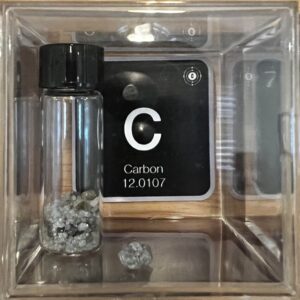Carbon
Atomic Number: 6
Atomic Mass: 12.011 u

Carbon, one of the most fundamental elements, is essential to all life on Earth and is present in countless forms and applications today. Though we may take it for granted, the journey of its discovery and its diverse modern uses tells a compelling tale.
A Discovery Rooted in Antiquity
The history of this element goes back to ancient times, although its formal discovery can be credited to several significant scientists across different eras. The earliest known uses date back to the Egyptians and Sumerians around 3750 BCE, who used charcoal (an early form of the element) to reduce copper, zinc, and tin ores in metal smelting.
However, the more scientific recognition of the element began much later. In 1789, French chemist Antoine Lavoisier identified it as a distinct element, calling it “carbone.” He demonstrated that this element, when burned in the presence of oxygen, produced carbon dioxide. This crucial experiment laid the foundation for much of our modern understanding of chemical reactions and the behavior of gases.
At roughly the same time, the English scientist Joseph Black also played an important role by studying what he called “fixed air,” now known as carbon dioxide, and its properties.
Modern Uses of an Ancient Element
In today’s world, this element plays a critical role in industries far beyond the realms of smelting and metallurgy. Here are some of the most vital uses:
- Energy Storage and Transfer: One of the most advanced uses is in the development of graphene, a material composed of a single layer of atoms arranged in a hexagonal lattice. Graphene is being explored for use in high-speed electronics, batteries, and even water filtration due to its extraordinary strength and electrical conductivity.
- Medical Applications: Another essential use is in the medical field, where activated forms are used in filters to purify water and air, and to treat poisonings by absorbing toxins. The biocompatibility of carbon-based materials also makes them ideal for prosthetics and surgical implants.
- Agriculture: In farming, this element is critical in the form of carbon dioxide, which plants use during photosynthesis to grow and produce oxygen. This balance is vital for maintaining life on Earth. Additionally, organic farming often relies on carbon-rich soil amendments to improve plant health.
- Construction and Architecture: Carbon fiber is used extensively in modern construction. It is lightweight, incredibly strong, and resistant to corrosion, making it perfect for everything from building bridges to creating sports equipment like bicycles and tennis rackets.
- Climate Impact and Environmental Technologies: In recent years, its role in climate change has come into sharp focus. Atmospheric CO2 levels, primarily from burning fossil fuels, are a major concern. Yet, carbon capture technologies are being developed to mitigate this impact by capturing and storing emissions before they enter the atmosphere.
- Manufacturing and Industry: In manufacturing, steel production relies heavily on carbon as an alloying element with iron. The result is a material that is not only durable but also versatile, used in everything from automobiles to skyscrapers.
The Element’s Future
As research continues, the uses of this element will likely grow. Carbon nanotubes, for example, are being developed for use in quantum computing and next-generation materials that could revolutionize multiple industries.
As we better understand both its limitations and potential, it is clear that the element that has been with us since ancient times will continue to be a cornerstone of technological advancement.
This simple element, discovered formally over two centuries ago in the laboratories of Europe, now forms the backbone of many modern technologies. From the air we breathe to the tools we use, its significance is undeniable—and its story is still being written.
 using WordPress and
using WordPress and
No responses yet